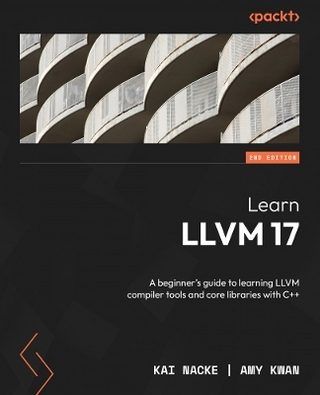
Xojo Unleashed
Apress (Verlag)
978-1-4842-9996-8 (ISBN)
- Keine Verlagsinformationen verfügbar
- Artikel merken
You'll start with an introduction to the fundamentals of the language, while also reviewing the basic programming principles a beginner will need to get started. This will help when moving on to controlling hardware such as lights, motors, LCD screens and sensors, using a Raspberry Pi. Later in the book, you'll study the more technical and advanced principles of Xojo, such as error handling, debugging, user interface design, mobile development and more. Experienced developers can jump in here and pick up the skills quickly. You'll also work with databases, REST APIs, XML and other data sources.
Xojo’s successes is proven, with over 100,000 users including a large, active online community. Xojo Unleashed will show you why the language provides more and more users the ability to write code quickly across platforms.
What You'll Learn
Build fully responsive web applications.
Develop and deploy mobile applications
Work with networking protocols to create client/server applications
Write code that works over multiple platforms
Who This Book Is For
Novice programmers, students and software engineers of all disciplines looking to write cross-platform code; professional developers looking to build applications written for embedded user; hobbyist programmers looking to build any utilities, apps and "quick hacks" to control various devices via Raspberry's GPIO.
Andrew Timmins is a software developer and Xojo enthusiast with over 25 years of experience in the programming world. Passionate about technology and education, Andrew has been using Xojo to create applications for various industries, including SEO, digital marketing, finance, manufacturing, healthcare, education and experiential events/entertainment. In addition to developing software, Andrew is an avid writer and educator, frequently contributing articles, tutorials, and educational resources to the Xojo community. When not working on software projects or writing, Andrew enjoys spending time with family, exploring nature, tinkering with electronics and experimenting with new technologies.
Chapter 1: Introduction to Xojo1.1 What is Xojo?
1.2 Advantages of using Xojo
1.3 Xojo vs. other languages
Chapter 2: Getting Started with Xojo
2.1 Installing Xojo
2.2 Creating a new project
2.3 Exploring the Xojo interface
2.4 Your first Xojo program
Chapter 3: The Xojo IDE
3.1 Code editor
3.2 Project browser
3.3 Inspector
3.4 Library
3.5 Debugging tools
Chapter 4: Variables, Constants, and Data Types
4.1 Variables and naming conventions
4.2 Constants
4.3 Data types in Xojo
4.4 Type conversion
Chapter 5: Control Structures and Loops
5.1 Conditional statements (If, Else, Select Case)
5.2 Loops (For, While, Do)
Chapter 6: Functions and Methods
6.1 Creating functions
6.2 Parameters and return values
6.3 Method overloading
6.4 Recursive functions
Chapter 7: Classes and Objects
7.1 Defining classes
7.2 Creating objects
7.3 Constructors and destructors
7.4 Inheritance and polymorphism
7.5 Encapsulation
Chapter 8: Error Handling and Debugging
8.1 Try, Catch, and Finally
8.2 Raising exceptions
8.3 Debugging techniques
Chapter 9: Working with Databases
9.1 Connecting to databases
9.2 Executing SQL queries
9.3 Working with recordsets
9.4 Database transactions
Chapter 10: User Interface Design
10.1 Creating user interfaces
10.2 Working with controls
10.3 Event-driven programming
10.4 Customizing the appearance
Chapter 11: Networking and Communication
11.1 Sockets and protocols
11.2 HTTP requests and web services
11.3 Serial communication
Chapter 12: Multithreading and Concurrency
12.1 Threads in Xojo
12.2 Creating and managing threads
12.3 Synchronization techniques
Chapter 13: File Handling and I/O Operations
13.1 Working with files and directories
13.2 Reading and writing files
13.3 Binary and text files
13.4 File manipulation techniques
Chapter 14: Creating Web Applications
14.1 Introduction to Xojo Web
14.2 Creating a web project
14.3 Designing web interfaces
14.4 Handling user input and events
14.5 Deploying web applications
Chapter 15: Mobile Development with Xojo
15.1 Introduction to Xojo Mobile
15.2 Setting up a Mobile Project
15.3 Mobile User Interface Design
15.4 Handling Mobile Events
15.5 Accessing Mobile Device Features
15.6 Mobile Data Storage and Persistence
15.7 Networking and Web Services
15.8 Mobile App Deployment and Distribution
Chapter 16: Deploying Xojo Applications
16.1 Compiling applications for different platforms
16.2 Distributing your applications
16.3 Updating and maintaining your applications
16.4 Tips for successful deployment
Chapter 17: Raspberry PI Development with Xojo
17.1 Introduction to Xojo on the Raspberry Pi
17.2 Setting up a Raspberry Pi Project
17.3 Raspberry Pi User Interface Design
17.4 Introduction to Raspberry Pi GPIO
17.5 Handling GPIO Events (Input/Output/PWM)
17.6 Communicating With SPI/I2C Devices
17.7 Introduction to the Rasperry Pi Camera
17.8 Effects & Streaming with the Raspberry Pi Camera
17.9 Raspberry Pi App Deployment and Distribution
Appendix A: Xojo Language Reference
A.1 Keywords
A.2 Operators
A.3 Predefined classes and functions
Appendix B: Resources and Further Reading
B.1 Online resources
B.2 Books and publications
B.3 Xojo community
| Erscheinungsdatum | 25.11.2023 |
|---|---|
| Zusatzinfo | 20 Illustrations, black and white; Approx. 270 p. 20 illus. |
| Verlagsort | Berkley |
| Sprache | englisch |
| Maße | 155 x 235 mm |
| Themenwelt | Mathematik / Informatik ► Informatik ► Programmiersprachen / -werkzeuge |
| Informatik ► Theorie / Studium ► Compilerbau | |
| Schlagworte | Cross Platform • Ios • iPad • iPhone • Mobile Development • object-oriented programming • Raspberry Pi • REALbasic • Web Development • Xojo |
| ISBN-10 | 1-4842-9996-5 / 1484299965 |
| ISBN-13 | 978-1-4842-9996-8 / 9781484299968 |
| Zustand | Neuware |
| Haben Sie eine Frage zum Produkt? |
aus dem Bereich


